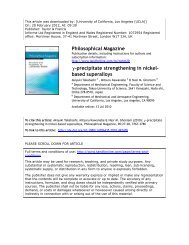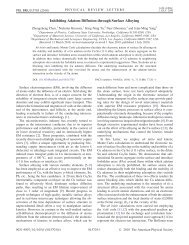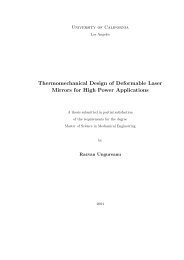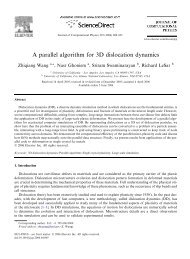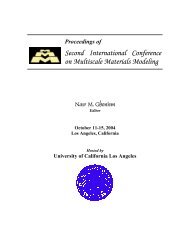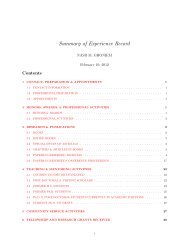FS&T Template - Nasr Ghoniem's Matrix Laboratory - UCLA
FS&T Template - Nasr Ghoniem's Matrix Laboratory - UCLA
FS&T Template - Nasr Ghoniem's Matrix Laboratory - UCLA
Create successful ePaper yourself
Turn your PDF publications into a flip-book with our unique Google optimized e-Paper software.
DEVELOPMENT STATUS OF A SiC-FOAM BASED FLOW CHANNEL INSERT<br />
FOR A U.S.-ITER DCLL TBM<br />
Shahram Sharafat 1 , Aaron Aoyama 1 , Neil Morley 1 , Sergey Smolentsev 1 , Y. Katoh 2 ,<br />
Brian Williams 3 , and <strong>Nasr</strong> Ghoniem 1<br />
1 University of California Los Angeles, 420 Westwood Plaza, Los Angeles, CA, 90095, U.S.A. shahrams@ucla.edu<br />
2 Oak Ridge National <strong>Laboratory</strong>, Oak Ridge, TN, 37831, U.S.A.<br />
2 Ultramet Inc., Pacoima, CA, 91331, U.S.A.<br />
The U.S.-ITER DCLL (Dual Coolant Liquid Lead)<br />
TBM (Test Blanket Module) uses a Flow Channel Insert<br />
(FCI), to test the feasibility of high temperature DCLL<br />
concepts for future power reactors. The FCI serves a<br />
dual function of electrical insulation, to mitigate MHD<br />
effects, and thermal insulation to keep steel-PbLi<br />
interface temperatures below allowable limits. As a nonstructural<br />
component, the key performance requirements<br />
of the FCI structure are compatibility with PbLi, longterm<br />
radiation damage resistance, maintaining insulating<br />
properties over the lifetime, adequate insulation even in<br />
case of localized failures, and manufacturability. The<br />
main loads on the FCI are thermally induced due to<br />
through the thickness temperature gradients and due to<br />
non-uniform PbLi temperatures along the flow channel<br />
(~1.6 m). A number of SiC-based materials are being<br />
developed for FCI applications, including SiC/SiC<br />
composites and porous SiC bonded between CVD SiC<br />
face sheets. Here, we report on an FCI design based on<br />
open-cell SiC-foam material. Thermo-mechanical<br />
analysis of this FCI concept indicate that a SiC-foam FCI<br />
structure is capable of withstanding anticipated primary<br />
and secondary stresses during operation in an ITER TBM<br />
environment. A complete 30 cm long prototypical segment<br />
of the FCI structure was designed and is being fabricated,<br />
demonstrating the SiC-foam based FCI structure to be<br />
very low-cost and viability candidate for an ITER TBM<br />
FCI structure.<br />
I. INTRODUCTION<br />
The U.S. ITER Double Coolant Lead Lithium<br />
(DCLL) Test Blanket Module (TBM) program aims to<br />
validate a future power reactor (DEMO) design concept,<br />
which is based on circulating liquid breeder (PbLi) at<br />
elevated temperatures of more than 700 o C and at low<br />
velocities of ~10 cm/s (Ref. 1) through the blanket. The<br />
candidate ITER TBM and DEMO structural materials are<br />
based on reduced activation ferritic/martensitic steel<br />
alloys, which have maximum allowable PbLi interface<br />
temperatures of less than ~470 o C. Higher PbLi operating<br />
temperatures require that the ferritic/martensitic based<br />
structures be thermally insulated from the breeder<br />
material. Furthermore, to mitigate the pressure drop due<br />
to magneto-hydrodynamic effects in liquid breeders, the<br />
metallic walls need to provide electrical insulation from<br />
the flowing PbLi. Ceramic coatings could provide both,<br />
electrical and thermal insulation, if micro-crack densities<br />
are kept below stringent levels and coating materials are<br />
compatible with the structural as well as liquid breeder<br />
materials. Due to these limitations, the concept of a Flow-<br />
Channel-Insert (FCI) was proposed for the EU advanced<br />
leadlithium blanket concept (Ref. 2) and for the US<br />
ARIES-ST blanket design (Ref. 3). The FCI is a<br />
standalone ceramic structure located inside the blanket<br />
flow channels. The FCI shields the metallic structure from<br />
high temperature breeder materials as well as insulates the<br />
bulk of liquid breeder material electrically from the wall.<br />
The FCI does not serve a structural purpose, which<br />
reduces the design requirements to merely surviving<br />
radiation, thermal, and mechanical loads imposed by the<br />
liquid breeder and the nuclear heating environments.<br />
Previously, SiC/SiC composites with degraded<br />
thermal and electrical conductivities have been proposed<br />
as FCI structural material (Ref. 2, 5, 6). However, the<br />
low conductivity requirements of the FCI structure,<br />
necessitates further R&D of SiC/SiC composite materials,<br />
such as using 2-D woven fiber architectures and doping of<br />
the SiC matrix to reduce conductivities across the<br />
thickness of the SiC/SiC structures. 2 Alternatively, an FCI<br />
structure based on sandwiching porous SiC between<br />
dense CVD SiC face sheets was proposed, because of low<br />
cost, ease of fabrication and limited verification R&D<br />
needs of CVI- and CVD SiC materials.<br />
FUSION SCIENCE AND TECHNOLOGY VOL. 56 AUG. 2009 883
Sharafat et al.<br />
SiC-FOAM BASED FLOW CHANNEL INSERT FOR DCLL TBM<br />
Chemical vapor infiltrated (CVI) open-cell SiC-foam<br />
was proposed as a candidate porous SiC material with<br />
dense CVD SiC closeout face sheets. Production of SiCfoam<br />
materials is a relatively mature technology, which<br />
(Ref. 7) and SiC foam<br />
structures with a variety of geometric configurations are<br />
now commercially available. 8 The primary advantage of<br />
using this technology is that all SiC materials are<br />
CVD/CVI based, which have been shown to have<br />
excellent radiation damage resistance, thermal stability,<br />
and chemical compatibility with PbLi.<br />
In this paper, we outline performance and material<br />
requirements of a SiC-based FCI structure, followed by<br />
the design of a prototypical FCI structure. Next, results of<br />
static thermo-mechanical analyses of a SiC-foam based<br />
FCI under ITER operating conditions are presented.<br />
Development and testing of SiC-foam based FIC material<br />
samples are discussed, and fabrication of 30 cm long<br />
prototypical FCI components are reported. We conclude<br />
with the results of first thermal exposure tests and planned<br />
liquid metal exposure tests of the complete FCI segments.<br />
II. FCI KEY PERFORMANCE REQUIREMENTS<br />
A number of performance requirements have to be<br />
met by the FCI structure, which include compatibility<br />
with high temperature PbLi, low through the thickness<br />
thermal conductivity, and low through the thickness<br />
electrical conductivity. However, specific required<br />
material properties depend on the reactor design (ITER,<br />
DEMO), the FCI design itself, as well as the blanket<br />
configuration and location within the reactor.<br />
Furthermore, future DEMO blanket designs will be based<br />
on optimization and sensitivity studies that will ultimately<br />
determine necessary performance parameters of the FCI<br />
for each, inboard and outboard blankets.<br />
The requirements for thermal- and electrical<br />
conductivity of an FCI structure were recently analyzed<br />
using 3-D magnetohydrodynamic models for a 5 mm to<br />
15 mm thick SiC FCI structures for a typical DEMO<br />
reactor design. 5 It was shown that the MHD pressure drop<br />
in a 2-m long poloidal duct dropped by a factor of 190 to<br />
5 depending on the electrical conductivity value of<br />
between 5 and 500 S/m, respectively. Furthermore, using<br />
a thermal conductivity value of 2 W/m-K the analysis<br />
showed that the interface temperature between the<br />
structure and PbLi decreased from 538 to 504 o C with<br />
increasing FCI electrical conductivity from 5 to 500 S/m.<br />
Hence, at present time required thermal- and<br />
electrical conductivity values of FCI structures can at best<br />
be expressed as a desired range: the through thickness<br />
electrical conductivity fall somewhere between 1 and 100<br />
S/m and the thermal conductivity is assumed to be less<br />
than 2 W/m-K for future DEMO Inboard and Outboard<br />
blanket designs (Ref. 1, 5).<br />
Chemical compatibility between the FCI structure<br />
and the liquid breeder PbLi is particularly critical for<br />
future DEMO reactors, where PbLi temperatures as high<br />
as 700 o C are required. Experiments with PbLi have<br />
shown that high-purity, chemical vapor deposited (CVD)<br />
SiC exposed to PbLi for up to 5000 h at 800 o C showed<br />
no sign of dissolved Si (Ref. 4). Hence, CVD SiC is<br />
considered chemically compatible with PbLi for ITER<br />
and DEMO operation. It is therefore more or less critical<br />
that FCI structures based on SiC materials would all have<br />
a high-density CVD face sheet in contact with the liquid<br />
PbLi.<br />
The FCI has to have adequate structural integrity<br />
capable of withstanding thermal and fluid loads without<br />
resulting in significant loss of insulating properties.<br />
Structural integrity depends on choice of materials,<br />
material architecture (for SiC/SiC composites), and FCI<br />
geometry, which are addressed in the next sections.<br />
Damage or cracks have to remain localized and ingress of<br />
liquid metal has to remain limited to the extent of the<br />
damage. Ingress of liquid PbLi into cracks that form<br />
during operation sho<br />
interior structure, which could result in increasing local<br />
thermal and electrical conductivity of the FCI.<br />
Liquid Metal Leak Tightness is critical for the FCI<br />
structure to prevent changes in thermal and electrical<br />
conductivity during operation. In case of localized<br />
damage, such as surface cracking, PbLi penetration<br />
should remain localized and be limited to the extent of the<br />
<br />
FCI structure.<br />
The mechanical integrity of the FCI structure must be<br />
adequate enough to withstand all primary and secondary<br />
stresses without failure and it must be capable of<br />
withstanding cracking stresses induced by through the<br />
thickness temperature drops of up to T ~100 K for US<br />
DCLL TBM and T~200 K for DEMO reactors. Dynamic<br />
Loads due to flow perturbations as well as off normal<br />
large temperature gradients along the duct must also be<br />
withstood by the FCI structure. Disruption events, such<br />
as Vertical Displacement Events (VDEs) in ITER or full<br />
disruptions in DEMO reactors may result in additional<br />
dynamic loads on the FCI structure resulting from rapid<br />
displacement or movements of the liquid PbLi within the<br />
duct.The impact of neutron irradiation induced damage on<br />
the FCI structure and material properties must be<br />
considered for the D-T Phase of ITER and full operation<br />
of DEMO. All of the aforementioned requirements of the<br />
FCI structure and material properties must remain<br />
fulfilled during neutron irradiation. Key FCI requirements<br />
are summarized in Table 1.<br />
III. FCI-STRUCTURE DESIGN<br />
A schematic of the U.S. ITER DCLL TBM is shown<br />
in Fig. 1. Details of the U.S. ITER DCLL TBM design are<br />
884 FUSION SCIENCE AND TECHNOLOGY VOL. 56 AUG. 2009
Sharafat et al.<br />
given in reference. 1 Liquid PbLi enters through a plenum<br />
near the bottom of the TBM module, flows up in the<br />
channels behind the plasma facing first wall (FW), and<br />
then at the top of the TBM turns around and flows<br />
downward to exit the TBM near the bottom. All internal<br />
PbLi breeder flow channels need to be protected by FCI<br />
structures, which includes the upper and lower turning<br />
sections. Here we present the design of the straight FCI<br />
section located in the upward channel behind the FW.<br />
Figure 2 is a close-up view of the schematic FCI structure<br />
relative to the ferritic/martensitic structure. There is a 2-<br />
mm gap between the FCI and the structure, which is filled<br />
with PbLi. The PbLi flow in the gap and inside the FCI is<br />
driven by the same pressure head. If necessary, pressure<br />
equalization between these two PbLi volumes can be<br />
achieved by openings. In this work, it is assumed that no<br />
significant pressure difference exists between the two<br />
PbLi volumes. The bulk of the PbLi travels with a mean<br />
velocity of about 0.06 m/s.<br />
TABLE I: Key Requirements of the FCI Structure<br />
PROPERTY<br />
KEY REQUIREMENT<br />
Thermal Insulation,<br />
RT - 700 o 2 to 5 W/m-K<br />
C (k th )<br />
Electrical Insulation,<br />
RT-700 o
Sharafat et al.<br />
SiC-FOAM BASED FLOW CHANNEL INSERT FOR DCLL TBM<br />
of the FCI. They can take the form of either pressure<br />
equalization holes or slots. However, these features have<br />
not yet been designed and are currently not included in<br />
the analysis.<br />
the proposed SiC materials are produced by a CVD<br />
process. A potential advantage of using the combination<br />
of SiC-foam with CVD face sheets is that CVD SiC<br />
materials have been established to have good resistance to<br />
neutron irradiation damage. However, the radiation<br />
performance of SiC foam materials has yet to be<br />
validated.<br />
Figure 5 shows a micrograph of the proposed FCI<br />
structure, which consists of SiC foam between two CVD<br />
SiC face sheets. The parts with 12% SiC foam exhibited<br />
flexure strength of 50.3 ± 1.4 MPa, while the parts with<br />
22% SiC foam had a strength of 115.4 ± 7.4 MPa (Ref.<br />
11). The SiC foam is integrally attached (mechanically<br />
and chemically bonded) to the CVD SiC faceplate. For a<br />
100 pores per linear inch SiC-foam, there are 10,000<br />
support points per square inch for the SiC face sheet. The<br />
foam is integrally fused to the CVD-SiC face sheet,<br />
because of the nominally 1 to 2 pore depth penetration of<br />
the face sheet into the foam. The reticulated ligamental<br />
structure of SiC foams provides favorable thermomechanical<br />
properties, such as high thermal shock<br />
resistance and the ability to withstand steep temperature<br />
gradients, by reacting stress through small movements of<br />
individual ligaments. Fully dense SiC structures are not<br />
capable of reducing stress through this micro-distortion<br />
behavior, and can result in microcracks.<br />
Fig. 3: Schematic of the segmented FCI structure; also a<br />
cross sectional view of a single sector and a close-up view<br />
of the bracket are shown (dimensions are in mm).<br />
III.A. SiC Foam-based FCI Material<br />
SiC/SiC composites have been suggested as<br />
structural materials of FCIs. However, these advanced<br />
SiC/SiC composites have thermal and electrical<br />
conductivities, which are above the desired limits. Figure<br />
4 shows typical un-irradiated SiC/SiC composite<br />
materials properties. Depending on irradiation<br />
temperature, dose, and architecture, SiC/SiC can<br />
experience a wide range in thermal conductivity<br />
degradation of K irr /K o ratios between 0.1 and 0.6 between<br />
400 o C and 1000 o C (Ref. 10). An effort is currently<br />
underway to develop new SiC/SiC composites with 2-D<br />
fiber architecture to satisfy the key requirements of<br />
electrical- and thermal conductivity limits outlined earlier.<br />
Here we report on the use off-the-shelf CVD-based<br />
SiC materials for the FCI, consisting of open-cell SiC<br />
foam sandwiched between CVD SiC face sheets. SiCfoams<br />
are routinely manufactured at low cost compared<br />
with SiC/SiC composites, which fulfill FCI conductivity<br />
requirements. No significant R&D development,<br />
especially neutron irradiation data is necessary, as all of<br />
Fig. 4: Transverse thermal (top) and electrical (bottom)<br />
conductivities of un-irradiated SiC/SiC composites. 9<br />
Figure 6 shows the thermal and electrical<br />
conductivities of SiC foam as a function of temperature<br />
886 FUSION SCIENCE AND TECHNOLOGY VOL. 56 AUG. 2009
Sharafat et al.<br />
for 65 and 100 pores per linear inch (ppi) foam at 10%<br />
and 20% density. The average thermal conductivity of<br />
10% dense, 100 ppi SiC foam is close to 1.0 W/m-K at<br />
700 o C, which is less than the required 2 W/m-K for the<br />
FCI structure. The effective electrical conductivity of FCI<br />
development structure with 8 mm thick, 20% dense, 65<br />
ppi foam and 0.08 mm thick face sheets was measured<br />
and found to be less than 0.2 S/m at a current of 1 A (Ref.<br />
11). Prior to testing, the residual carbon at the core of the<br />
SiC foam ligaments was removed by oxidation. The low<br />
electrical conductivity of the FCI development piece<br />
indicates that design requirements of less than ~1 S/m are<br />
readily met using SiC foam sandwiched between two<br />
CVD SiC face sheets.<br />
SiC-FOAM BASED FLOW CHANNEL INSERT FOR DCLL TBM<br />
CVD SiC face sheets. For finite element analysis a three<br />
layered material model was used to represent the CVD-<br />
Foam-CVD structure of the FCI wall. Here, we assume<br />
that each layer consists of a homogeneous material. For<br />
the 1-mm thick face sheets, CVD-SiC material properties<br />
-<br />
measured SiC-foam properties were assigned. (Table II).<br />
This analysis is, thus by its nature not exact in that the<br />
local response of individual SiC-foam ligaments are not<br />
analyzed. Therefore, the uncertainty associated with this<br />
FEM analysis must be taken into account in ascertaining<br />
the performance of this structure.<br />
Fig. 5: (a) Cross-sectional photograph of 10-mm thick<br />
12% dense CVD SiC foam with 1.8 mm thick CVD SiC<br />
face sheets; (b) 5-mm thick 22% dense CVD SiC foam<br />
with 1.8 mm thick CVD SiC face sheets; (both 5X); (c)<br />
FCI development specimen in 4-point bend fixture; (d)<br />
post-test photo of torch-tested SiC faceplate surface<br />
(1200 o C) (2X). 11<br />
Limited room temperature mechanical property<br />
measurements of SiC foam have been made. Figure 7<br />
shows the strength and modulus of SiC foam as functions<br />
of bulk density. 11 Under compression, 10% dense SiC<br />
foam (0.32 g/cc) had a modulus of about 6 GPa, which<br />
rises to about 15 GPa at a 20% density. In tension, the<br />
modulus of 10% and 20% dense SiC foams are about 3<br />
GPa and 8 GPa, respectively. Tensile/compressive<br />
strengths of 10% and 20% SiC foams are about 3.5/10.5<br />
MPa and 7.6/27.2 MPa, respectively.<br />
IV. THERMO-MECHANICAL ANALYSIS<br />
The FCI model used for thermo-mechanical analysis<br />
is shown in Fig. 3, which shows a cross sectional view of<br />
one of five FCI segment. The FCI panel consists of a 3-<br />
mm thick foam sandwiched between two 1-mm thick<br />
Fig. 6: Thermal conductivity versus temperature of 65 and<br />
100 ppi SiC foam at 10% and 20% dense and electrical<br />
conductivity for 20% dense SiC foam with 1.8-mm CVD<br />
face-sheets (w/o carbon core). 11<br />
Two thermo-mechanical analyses were conducted,<br />
one on a single segment with a constant heat flux from the<br />
inside of the FCI and the other on the entire structure<br />
using detailed temperature maps, generated in conjunction<br />
with magnetohydrodynamic models. 5 The thermal loading<br />
conditions for the single FCI segment were chosen such<br />
that a mean temperature difference of about 40 o C (Ref. 1)<br />
would exist between the inside and the outside of the FCI.<br />
A heat flux of 0.2 MW/m 2 was applied to all inner areas<br />
of the FCI and the outside surfaces were cooled assuming<br />
a PbLi temperature of 450 o C with a heat transfer<br />
coefficient of 10 000 W/m 2 -K. The brackets are not<br />
bonded to the FCI SiC-foam panels, rather they are<br />
simply slid into each other. Hence, there is a thermal<br />
resistance across the contact area between the bracket and<br />
the face sheet. The heat transfer coefficient of ceramic-toceramic<br />
joints ranges between 500 W/m 2 -K to 3000<br />
FUSION SCIENCE AND TECHNOLOGY VOL. 56 AUG. 2009 887
Sharafat et al.<br />
SiC-FOAM BASED FLOW CHANNEL INSERT FOR DCLL TBM<br />
W/m 2 -K, depending on the interface smoothness and<br />
contact pressure. For unpolished CVD SiC surfaces a heat<br />
transfer coefficient of 1500 W/m 2 -K is assumed, which<br />
translates into a thermal resistance of 6.67×10 -4 K-m 2 /W.<br />
The location of thermal resistance interfaces are indicated<br />
in Fig. 9. The FCI material properties used for the<br />
analyses are summarized in Table II. The CVD-SiC<br />
brackets, shown in Fig. 3 serve to secure adjacent FCI<br />
segments to each other and to provide a stand-off distance<br />
from the TBM wall structure. However, following<br />
thermo-mechanical analysis of the brackets it was decided<br />
<br />
brackets. Figure 8 shows the latest design of the bracket<br />
along with characteristic dimensions.<br />
outside of the bracket is maintained at about 450 o C. The<br />
majority areas of the FCI outside panels are between 470<br />
and 480 o C, while the inside panels are closer to 510 o C.<br />
Fig. 7: Strength and modulus of SiC foam as a function<br />
of bulk density. 11<br />
TABLE II: FCI material properties at room temperature*<br />
PROPERTY<br />
CVD-SiC (12) SiC-Foam (11)<br />
(100% dense) (20% dense)<br />
Thermal<br />
conductivity<br />
48 2<br />
(W/m-K)<br />
Thermal<br />
expansion<br />
4.55 4.20<br />
(10 -6 /K)<br />
Specific heat<br />
(J/kg-K)<br />
1096 1096<br />
Density<br />
(kg/m 3 )<br />
3210 630<br />
Young's<br />
modulus (GPa)<br />
430 11<br />
Poisson's ratio 0.21 0.22<br />
Tensile<br />
strength (MPa)<br />
150 7.6<br />
*un-irradiated properties<br />
Fig. 8: Solid model of 1/4th of a single FCI segment<br />
showing bracket details (dim. in mm); this model was<br />
used for thermo-mechanical analysis with top half of the<br />
bracket removed for symmetry BCs.<br />
Thus, the largest temperature difference between the<br />
inside and outside of the FCI exists near the brackets due<br />
to the thermal resistance between bracket and FCI panels.<br />
The corresponding von Mises stress contours are shown<br />
in Fig. 10. Average stress levels along the surface of the<br />
CVD-SiC brackets are of the order of 100 MPa, while<br />
those on the foam/CVD face sheets are below 80 MPa.<br />
IV.A. FCI Segment Thermo-Mechanical Response<br />
To model typical ITER conditions, the response of<br />
the FCI segment with a uniform through the thickness<br />
gradient of 40 o C was analyzed. Results of this thermal<br />
analysis are shown in Fig. 9. The high thermal resistance<br />
between the bracket and the FCI panels results in the<br />
maximum temperatures inside the top and bottom of the<br />
FCI panels near the brackets of about 550 o C, while the<br />
Fig. 9: Temperature contours of the SiC Foam-based FCI<br />
segment; insert shows thermal resistance surfaces<br />
between bracket and FCI panels (inner FCI w<br />
MW/m 2 ; outer FCI wall: cooled with PbLi at 450 o C and<br />
h=10,000 W/m 2 -K).<br />
The stresses are highest along the outside of the SiC<br />
brackets, for two reasons: (1) the bracket is assumed to be<br />
888 FUSION SCIENCE AND TECHNOLOGY VOL. 56 AUG. 2009
Sharafat et al.<br />
100% dense CVD SiC with a high modulus of 412 GPa<br />
(high stiffness), and (2) the FCI foam panels exert stresses<br />
due to their thermal expansion which concentrates along<br />
the upper and lower edges of the foam panels. The high<br />
thermal resistance between the bracket and the foam panel<br />
causes the highest temperature gradients to occur near the<br />
FCI foam panel edges. This exacerbates the stresses in the<br />
brackets. This analysis indicates that improved thermal<br />
heat transfer coefficient between the bracket and the FCI<br />
foam panels are desirable to reduce temperature gradients<br />
near the support brackets.<br />
Figure 10 also plots the detailed localized stress<br />
levels along the inside edge between bracket and FCI<br />
foam panel. Stress levels in the FCI foam/CVD structure<br />
are above the tensile stress limit (~120 MPa) for unirradiated<br />
CVD SiC materials, with stresses in the bracket<br />
material being about 10 MPa to 20 MPa higher. These<br />
results indicate that the bracket design has to be modified<br />
in order to reduce stresses. Potential reduction in stress<br />
levels may be achieved, by rounding of all edges and<br />
changes and by changing bracket geometry.<br />
SiC-FOAM BASED FLOW CHANNEL INSERT FOR DCLL TBM<br />
in Figure 11 (Ref. 5). The maximum temperatures along<br />
the FCI structure occurs toward the top (exit) of the FCI,<br />
in addition, the temperature distributions are not<br />
symmetrical nor are the uniform.<br />
Fig. 11: Temperature contour maps of FCI surfaces: (a)<br />
behind FW (inside the FCI); (b) behind FW (outer); (c)<br />
back of the FCI (inner); (d) back of the FCI (outer).<br />
Fig. 10: Thermal stress contours of the SiC-Foam Based<br />
FCI segment; also shown are the stresses along the edge<br />
between the SiC bracket and CVD SiC face sheet.<br />
IV.B. Full-length FCI Thermo-Mechanical Response<br />
Based on 3-D magnetohydrodynamic calculations,<br />
detailed temperature distributions along the inside and<br />
outside faces of the entire 1.3 m long FCI structure were<br />
developed for typical ITER operations, which are shown<br />
This results in non-uniform thermal gradients across the<br />
FCI structure, which differ significantly from the simple<br />
uniform temperature conditions used to investigate a<br />
single segment (Fig. 8 Fig. 10). Figure 12 shows the<br />
results of the thermal analysis of the full length FCI<br />
structure. Temperatures along the FCI range from a low<br />
of 343 o C at the inlet to 427 o C at the outlet. The<br />
temperature gradient across the FCI structure at the exit is<br />
between 30 o C and 40 o C, while at the bottom the gradient<br />
is less than 15 o C.<br />
In calculating the stress distributions, we considered<br />
as a primary load the pressure head of PbLi along the 1.3<br />
m height of the FCI. The maximum pressure load is of the<br />
order of 0.1 MPa exerted at the bottom and from the<br />
inside of the FCI. We did not include any pressure<br />
difference between the inside and outside of the FCI<br />
structure, because these estimates were not available. The<br />
von Mises stress contours of the combined thermal plus<br />
pressure loads are shown in Fig. 13. The maximum<br />
stresses of about 66 MPa occur above the mid-plane of<br />
the FCI on the FCI panel and behind the bracket. The<br />
stresses do not vary greatly as a function of FCI height, in<br />
fact most of the FCI structure experiences relatively<br />
uniform stress levels, ranging between 20 MPa and 50<br />
MPa, with the lowest stresses occurring at the brackets.<br />
The combined von Mises stresses in the FCI structure<br />
made of SiC-foam sandwiched between CVD SiC face<br />
sheets and supported by CVD SiC brackets are below the<br />
allowable stress levels of for CVD SiC (~120 MPa).<br />
FUSION SCIENCE AND TECHNOLOGY VOL. 56 AUG. 2009 889
Sharafat et al.<br />
SiC-FOAM BASED FLOW CHANNEL INSERT FOR DCLL TBM<br />
SiC face sheets. 8 The FCI segment under construction is<br />
116 cm × 116 cm × 300 cm tall. Standard SiC foam<br />
processing involves conversion of polyurethane foam to<br />
99% porous carbon foam billet, which is then cut into 130<br />
× 130 × 300 mm long pieces. The FCI ID is established<br />
by press fitting a mandrel of desired size into the foam<br />
and the OD is formed with a fly-cutter (carbon foam is<br />
easily machinable). Next, the carbon foam is infiltrated<br />
with CVD SiC to the desired volume density. Finally, the<br />
SiC face sheets are CVD deposited on the outside of the<br />
SiC foam. Figure 14 shows a prototypical SiC-foam core<br />
prior to the application of the face sheet.<br />
VI. SUMMARY AND CONCLUSIONS<br />
Fig. 12: Temperature contours along the FCI structure.<br />
However, more detailed analysis is required to ascertain<br />
the impact of PbLi pressure differences between the<br />
inside and outside of the FCI. Furthermore, in these<br />
analyses we did not consider the actual mechanical<br />
contact between the FCI structure and the TBM walls.<br />
These contacts have to be designed to allow the FCI to<br />
expand without creating clamping loads on the FCI.<br />
Lastly, no dynamic loading on the FCI structure was<br />
analyzed.<br />
The key requirements and performance parameters of<br />
a FCI structure for DCLL blankets were discussed.<br />
Primary requirements are low electrical and thermal<br />
conductivity. Electrical conductivity ranging between
We presented here the design, the thermo-mechanical<br />
analysis, and the prototype fabrication status of a SiCfoam<br />
based FCI structure.<br />
The flow channels for PbLi in the ITER DCLL TBM<br />
design are about 1.6 m high. Allowing for supply and<br />
return space at the bottom and the top of the channel a<br />
straight FCI structure of 1.3 m is required. The 1.3 m tall<br />
FCI structure was divided into five 0.25 m tall segments,<br />
which are assembled using CVD-SiC brackets. Two<br />
analyses were performed, one with uniform through the<br />
thickness temperature gradients of 40 o C and one with<br />
established ITER relevant non-uniform temperature<br />
gradients.<br />
The porous FCI design is based on a 3-mm thick SiCfoam<br />
core between two 1-mm thick CVD SiC face sheets.<br />
The current design uses brackets to assemble five 25-cm<br />
tall FCI segments. Thermo-structural analysis of a single<br />
section with a uniform temperature gradient shows that<br />
the thermal resistance between the brackets and the FCI<br />
panels would have to be minimized in order to reduce<br />
thermal stresses in the FCI panels to acceptable levels.<br />
A thermo-mechanical analysis of the full-length FCI<br />
structure, 1.3 m long including the hydrostatic pressure<br />
head of PbLi was also performed. Detailed FCI-breeder<br />
interface temperature distributions based on 3-D<br />
magnetohydrodynamic calculations representative of<br />
ITER operations were using and mapped as thermal<br />
boundary conditions onto the full-length FCI walls.<br />
Maximum temperatures (~430<br />
o C) and temperature<br />
gradients (~40 o C) were found to be highly localized in<br />
the top region (exit) of the FCI structure. Calculated von<br />
Mises stresses were shown to be relatively evenly<br />
distributed over the entire FCI structure, ranging between<br />
20 and 50 MPa. Maximum stresses (~66 MPa) were<br />
shown to occur on the FCI panel underneath a bracket<br />
near the mid plane of the FCI structure. The preliminary<br />
analysis of a SiC-foam based FCI indicates that this<br />
concept satisfies key design requirements for ITER<br />
operation.<br />
Ultramet Inc. is fabricating a prototype of the SiCfoam<br />
based FCI consisting of a 5-mm SiC-foam core with<br />
1.8-mm thick CVD SiC face sheets. The FCI segment<br />
under construction is 116 cm×116 cm×300 cm tall. 8<br />
ACKNOWLEDGMENTS<br />
This work was supported by the US. Department<br />
of Energy, Office of Fusion Energy Sciences through an<br />
SBIR Phase-II Grant to Ultramet Inc.<br />
REFERENCES<br />
Sharafat et al.<br />
1. C.P.C. Wong, S. Malang, M. Sawan, M. Dagher, S.<br />
Smolentsev, B. Merrill, M. Youssef, S. Reyes, D.K.<br />
SiC-FOAM BASED FLOW CHANNEL INSERT FOR DCLL TBM<br />
Sze, N.B. Morley, S. Sharafat, P. Calderoni, G.<br />
Sviatoslavsky, R. Kurtz, P. Fogarty, S. Zinkle, M.<br />
Abdou, An overview of dual coolant Pb17Li breeder<br />
first wall and blanket concept development for the US<br />
ITER-TBM design, Fusion Engineering and Design 81<br />
(2006) 461467.<br />
2. P. Norajitra, L. Bühler, U. Fischer, K. Kleefeldt, S.<br />
Malang, G. Reimann, H. Schnauder, L. Giancarli, H.<br />
Golfier, Y. Poitevin, J.F. Salavy, The EU advanced<br />
lead lithium blanket concept using SiC f /SiC flow<br />
channel inserts as electrical and thermal insulators,<br />
Fusion Engineering and Design 5859 (2001) 629<br />
634.<br />
3. F. Nadjmabadi and The ARIES Team, Overview of<br />
the ARIES-RS reversed-shear tokamak power plant<br />
study, Fusion Engineering and Design 38 (1997) 325.<br />
4. B.A. Pint, J.L. Moser, P.F. Tortorelli, Investigation of<br />
PbLi compatibility issues for the dual coolant blanket<br />
concept, Journal of Nuclear Materials 367370 (2007)<br />
11501154.<br />
5. S. Smolentsev, M. Abdou, N.B. Morley, M. Sawan, S.<br />
Malang, C. Wong, Numerical analysis of MHD flow<br />
and heat transfer in a poloidal channel of the DCLL<br />
blanket with a SiCf/SiC flow channel insert, Fusion<br />
Engineering and Design 81 (2006) 549553.<br />
6. C.P.C. Wong, V. Chernov, A. Kimura, Y. Katoh, N.<br />
Morley, T. Muroga, K.W. Song, Y.C. Wu, M. Zmitko,<br />
ITER-Test blanket module functional materials,<br />
Journal of Nuclear Materials 367370 (2007) 1287<br />
1292.<br />
7. A.A. Wereszczak, E. Liu, V. Heng, T.P. Kirkland and<br />
M.K. Ferber, The high temperature compressive<br />
strength of non-oxide ceramic foams, Materials<br />
Science and Engineering A, Volume 219, Issues 1-2,<br />
30 November 1996, 224-228.<br />
8. Ultramet Inc., Pacoima, CA 91221, USA;<br />
http://www.ultramet.com/, accessed Dec. 2008.<br />
9. G. E. Youngblood, R. J. Kurtz, and R. H. Jones,<br />
SIC/SIC DESIGN FOR A FLOW CHANNEL<br />
INSERT, Semi-Annual Progress Report, 2004,<br />
Volume 37, 3-8.<br />
10. G. E. Youngblood, D. J. Senor and R. H. Jones,<br />
Effects of irradiation and post-irradiation annealing on<br />
the thermal conductivity/diffusivity of monolithic SiC<br />
and f-SiC/SiC composites, J. Nucl. Mater. 329-333<br />
(2004) 507-512.<br />
11. B. Williams, Ultramet Internal Technical Memo, Feb.<br />
2007, Ultramet Inc., Pacoima, CA 91221, USA.<br />
12. Y. Katoh, Oak Ridge National <strong>Laboratory</strong>, ORNL TN,<br />
private communications, May 2006.<br />
13. S. Smolentsev, et al., Characterization of key<br />
magnetohydrodynamic phenomena in PbLi flows for<br />
the US DCLL blanket, Fusion Eng. Des. (2008),<br />
doi:10.1016/j.fusengdes.2008.07.023<br />
FUSION SCIENCE AND TECHNOLOGY VOL. 56 AUG. 2009 891



